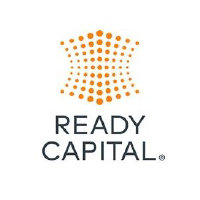
Ready Capital Corp
NYSE:RC


| US |

|
Johnson & Johnson
NYSE:JNJ
|
Pharmaceuticals
|
| US |

|
Berkshire Hathaway Inc
NYSE:BRK.A
|
Financial Services
|
| US |

|
Bank of America Corp
NYSE:BAC
|
Banking
|
| US |

|
Mastercard Inc
NYSE:MA
|
Technology
|
| US |

|
UnitedHealth Group Inc
NYSE:UNH
|
Health Care
|
| US |

|
Exxon Mobil Corp
NYSE:XOM
|
Energy
|
| US |

|
Pfizer Inc
NYSE:PFE
|
Pharmaceuticals
|
| US |

|
Palantir Technologies Inc
NYSE:PLTR
|
Technology
|
| US |

|
Nike Inc
NYSE:NKE
|
Textiles, Apparel & Luxury Goods
|
| US |

|
Visa Inc
NYSE:V
|
Technology
|
| CN |

|
Alibaba Group Holding Ltd
NYSE:BABA
|
Retail
|
| US |

|
3M Co
NYSE:MMM
|
Industrial Conglomerates
|
| US |

|
JPMorgan Chase & Co
NYSE:JPM
|
Banking
|
| US |

|
Coca-Cola Co
NYSE:KO
|
Beverages
|
| US |

|
Walmart Inc
NYSE:WMT
|
Retail
|
| US |

|
Verizon Communications Inc
NYSE:VZ
|
Telecommunication
|
Utilize notes to systematically review your investment decisions. By reflecting on past outcomes, you can discern effective strategies and identify those that underperformed. This continuous feedback loop enables you to adapt and refine your approach, optimizing for future success.
Each note serves as a learning point, offering insights into your decision-making processes. Over time, you'll accumulate a personalized database of knowledge, enhancing your ability to make informed decisions quickly and effectively.
With a comprehensive record of your investment history at your fingertips, you can compare current opportunities against past experiences. This not only bolsters your confidence but also ensures that each decision is grounded in a well-documented rationale.
Do you really want to delete this note?
This action cannot be undone.

| 52 Week Range |
6.4658
8.7967
|
| Price Target |
|
We'll email you a reminder when the closing price reaches USD.
Choose the stock you wish to monitor with a price alert.

|
Johnson & Johnson
NYSE:JNJ
|
US |

|
Berkshire Hathaway Inc
NYSE:BRK.A
|
US |

|
Bank of America Corp
NYSE:BAC
|
US |

|
Mastercard Inc
NYSE:MA
|
US |

|
UnitedHealth Group Inc
NYSE:UNH
|
US |

|
Exxon Mobil Corp
NYSE:XOM
|
US |

|
Pfizer Inc
NYSE:PFE
|
US |

|
Palantir Technologies Inc
NYSE:PLTR
|
US |

|
Nike Inc
NYSE:NKE
|
US |

|
Visa Inc
NYSE:V
|
US |

|
Alibaba Group Holding Ltd
NYSE:BABA
|
CN |

|
3M Co
NYSE:MMM
|
US |

|
JPMorgan Chase & Co
NYSE:JPM
|
US |

|
Coca-Cola Co
NYSE:KO
|
US |

|
Walmart Inc
NYSE:WMT
|
US |

|
Verizon Communications Inc
NYSE:VZ
|
US |
This alert will be permanently deleted.
 Ready Capital Corp
Ready Capital Corp
Ready Capital Corp
Ready Capital Corp. thrives as a diversified financial firm, skilfully navigating the complexities of the real estate and lending sectors. With a focus on supporting small to medium-sized businesses, it operates through multiple channels that cater to various aspects of real estate finance. At its core, Ready Capital specializes in originating, acquiring, and servicing a diversified portfolio of small balance commercial loans. These loans are primarily secured by commercial real estate, including multifamily, office, retail, and hospitality properties. The company strategically underwrites and structures these loans to meet the nuanced needs of its clients, ensuring both flexibility and competitiveness in the market.
The company's revenue is anchored in its adept ability to manage risk and capitalize on its extensive real estate market expertise. Through its well-established loan conduit, Ready Capital gains fees from originating loans and earns interest income from its portfolio. Additionally, by securitizing loans and selling them on secondary markets, it frees up capital to reinvest, creating a continuous cycle of growth and profit. Another pillar supporting its business model is its government-guaranteed lending offerings, which provide an added layer of security and opportunity for diverse revenue streams. Ready Capital also benefits from servicing income, as it continues to manage many seasoned loans, ensuring a steady income flow even beyond initial origination. Through this multifaceted approach, the company not only reinforces its financial foundation but also positions itself adeptly in the dynamic world of real estate financing.

Ready Capital Corp. thrives as a diversified financial firm, skilfully navigating the complexities of the real estate and lending sectors. With a focus on supporting small to medium-sized businesses, it operates through multiple channels that cater to various aspects of real estate finance. At its core, Ready Capital specializes in originating, acquiring, and servicing a diversified portfolio of small balance commercial loans. These loans are primarily secured by commercial real estate, including multifamily, office, retail, and hospitality properties. The company strategically underwrites and structures these loans to meet the nuanced needs of its clients, ensuring both flexibility and competitiveness in the market.
The company's revenue is anchored in its adept ability to manage risk and capitalize on its extensive real estate market expertise. Through its well-established loan conduit, Ready Capital gains fees from originating loans and earns interest income from its portfolio. Additionally, by securitizing loans and selling them on secondary markets, it frees up capital to reinvest, creating a continuous cycle of growth and profit. Another pillar supporting its business model is its government-guaranteed lending offerings, which provide an added layer of security and opportunity for diverse revenue streams. Ready Capital also benefits from servicing income, as it continues to manage many seasoned loans, ensuring a steady income flow even beyond initial origination. Through this multifaceted approach, the company not only reinforces its financial foundation but also positions itself adeptly in the dynamic world of real estate financing.






























 You don't have any saved screeners yet
You don't have any saved screeners yet
